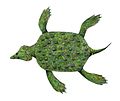| Martinectes Temporal range: Late Cretaceous (late Campanian), | |
|---|---|
 | |
| Skeleton mount, University of Michigan Museum of Natural History | |
| Scientific classification | |
| Kingdom: | Animalia |
| Phylum: | Chordata |
| Class: | Reptilia |
| Superorder: | † Sauropterygia |
| Order: | † Plesiosauria |
| Superfamily: | † Plesiosauroidea |
| Family: | † Polycotylidae |
| Subfamily: | † Polycotylinae |
| Clade: | † Dolichorhynchia |
| Genus: | † Martinectes Clark, O'Keefe & Slack, 2023 |
| Type species | |
| †Martinectes bonneri Adams, 1997 | |
| Synonyms | |
| |
Martinectes is an extinct genus of polycotylid plesiosaur from the Late Cretaceous (Campanian stage) of North America and possibly European Russia. The genus contains a single species M. bonneri, known from multiple skeletons and skulls. Martinectes was historically considered to represent a species of the genus Trinacromerum and later Dolichorhynchops before it was moved to its own genus. [1] It was a large polycotylid measuring around 5.5–7 metres (18–23 ft) long.







